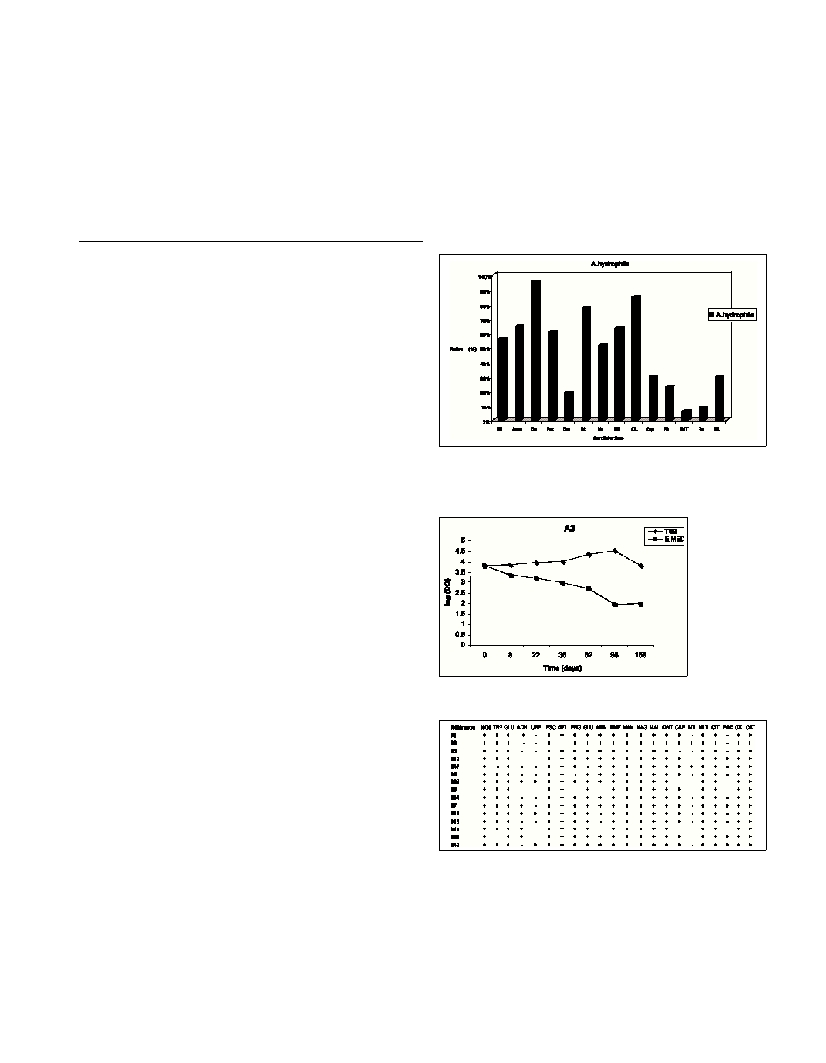Rapp. Comm. int. Mer Médit., 37,2004
272
A SUMMARY DESCRIPTION OF THE MAIN BACTERIAL SPECIES PRESENT
IN TUNISIAN COASTAL AREAS
EL Bour M.*, Attia El Hili H., Lakhal F., Ochi I., Mraouna R et El Abed A.
Lab. de Pathologie – INSTM – Salammbô, Tunisie - * monia.elbour@instm.rnrt.tn
Abstract
Monitoring different bacterial populations in coastal and lagoonal areas in Tunisia allowed us to distinguish more than 600 bacterial strains
from seawater, sediments, shellfish and moribund fishes. Thirty-six different aerobic and anaerobic bacterial species were isolated.
Aeromonas hydrophilawas the most dominant species isolated during the last decade (75%). Biotyping methods were used to characterize
52 different biotypes within this species. Antimicrobial typing showed that multi-resistant strains were common among A. hydrophila.
Experimental infection assays indicated negative effect of A. hydrophilaon the mussel (Mytilus galloprovencialis). Studies are currently
conducted to determine the effect of oligotrophic stress upon the biochemical, molecular and virulence characteristics of A. hydrophila.
Keywords : bacteria, aeromonads, biotyping, survival, pathogenesis.
Introduction
By using a biomonitoring approach for several coastal regions in
Tunisia, we found that different bacterial populations were
widespread in these areas [1]. Aerobic and anaerobic bacterial
populations showed high levels of heterogeneity [2]. The present work
describes features of the main bacterial species (Aeromonas
hydrophila)present in Tunisian coastal areas.
Materials and Methods
Sampling and isolation: different bacterial strains were isolated from
costal and lagoonal Tunisian ecosystems originating from the water
column, sediment, shellfish and moribund fishes during the period
1994-2001. All the bacterial strains (mesophilic and psychrophilic
aerobic and anaerobic populations) were isolated on basis of growth
on selective media [3s] and morphological features.
Biotyping and antibacterial sensitiveness analysis: the characteriza-
tion tools included: production of catalase and oxydase enzymes and
biochemical Api system profiles (Api 20E, Api 20NE, Api 50CHE and
Api 32Ana) besides the Biolog test of Micromer. The antibacterial
sensitivity profiles for all the bacteria isolated were detected by the
standard antibiogram method.
Oligotrophic stress analysis: The ability of Aeromonas hydrophila
strains to survive in seawater was experimentally tested in micro-
cosms inoculated and incubated at ambient temperature (about 20°C)
in the dark without shaking. Growth and survival of bacteria were fol-
lowed periodically by viable counts and measurements of optical den-
sities at wavelength (at 620nm).
Experimental infection assays of M. galloprovencialis: These assays
were done to test effect of A.hydrophilaspecies on mussels maintai-
ned under farming conditions. Thus, we inoculated samples of mus-
sels with suspension of A. hydrophila(suspension title = 5.10
7
cells/ml). Biological modifications of M. galloprovincialiswere
detected using the index condition measured periodically.
Results and Discussion
About 600 bacterial strains (87% aerobic species and 13%
anaerobic species) were isolated from diverse habitats including
water, sediments, shellfish and moribund fishes. The biochemical
characterization profiles indicated 11 anaerobic species and 25
aerobic species.
A. hydrophilawas the most dominant species isolated (75%).
According to the enzymatic and metabolic tests, we distinguished 52
different biochemical profiles within the species A. hydrophila. The
main profiles (15 biotypes) are listed in Table 1.
The results of antibiotic sensitivity tests showed that, multi-
resistance patterns were common to more than one biochemical
profile of A. hydrophila (Fig.1). No specific correlation was found
between biotypes and antibiotic resistance profiles obtained.
Under oligotrophic conditions, A. hydrophilastrains grew slowly
during the initial 8 d of incubation. Subsequently, the viable counts
decreased and no growth was detected after 158 d (Fig.2).
Mussels infected by A. hydrophilashowed structural modifications
of gonads. The index condition measured was in?uenced by the A.
hydrophilastrains injected.
Conclusion
Aerobic mesophilic bacteria were abundant in coastal ecosystems.
Within these populations, A. hydrophilawas the dominant species. Its
growth seems to be in?uenced by the oligotrophic conditions of the
seawater. Bivalves harboured different kinds of aerobic mesophilic
bacteria. It seems that shellfish were affected by high concentration of
mesophilic aeromonads.
Fig. 1: Antibacterial resistance profiles of Aeromonads (A.hydrophila)
Legend: PG
: penicillin
G,
Amx : amoxicillin,
Ox
: oxacillin,
Fox
: cefoxitin,
Cro
: ceftriaxon,
St
: Streptomycin,
Ne
: neomycin,
AR
: flumequin,
NN
:
tobramycin,
OL
: olendomycin,
C
: Chloramphenicol,
FM
: furans,
SXT
:
Trimethoprim-sulfamids,
Ra
: Rifamycin
Table I : The main biotypes described within the species Aeromonas
hydrophila
Legend :
(+) : positive reaction to the enzymatic or metabolic test, (-)
: negative reaction to the test. (No3): nitrate reduction, (TRP) :
Tryptophane, (ADH) : Arginine dihydrolase, (Ure) : Urease, (ESC) :
Esculine, (GEL) : Gelatinase, (PNG) : Beta galactosidase, (Ara) :
Arabinose, (Mne) : Mannose, (Man) : Mannitol, (Nag) : N-
acetylglucosamine, (Mal) : Maltose, (Gnt) : Gluconate, (Cap) : Caprate,
(Adi): Adipate, (Mlt) : Malate, (Cit) : Citrate, (Pac) : Phenyl acetate,
(Ox) : oxydase, (Cat) : Catalase.
References
1-El Bour M., Attia El Hili H., Mraouna R. and Ayari W., 2001.
Bacteriological Study of Mesophyllic Aeromonads Distribution in
Shellfish. Proceedings of the fifth international Conference on the
Mediterranean coastal environment, vol.1, pp 556-565.
Fig. 2 : Survival
curves of A.
hydrophilain
Trypcase Soja
Broth (TSB ) and
in sea water

